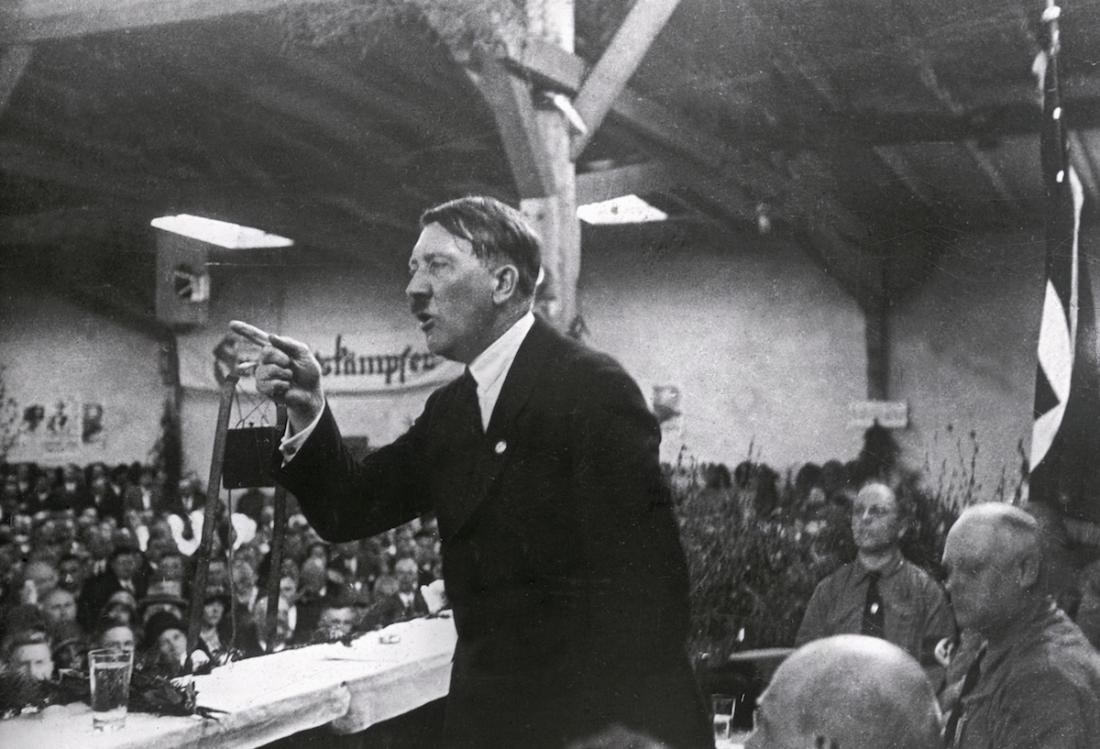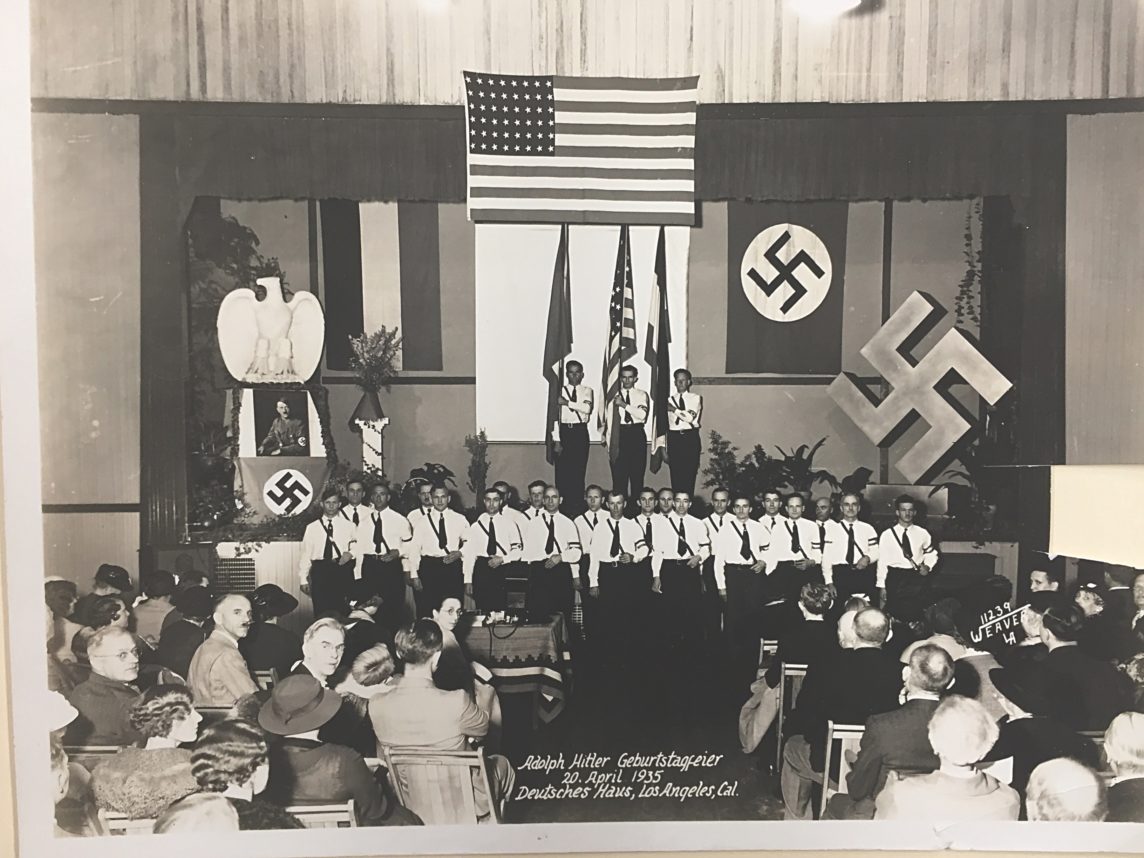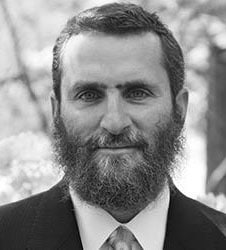 1935: Nazi leader Adolf Hitler speaks in front of microphones and gestures with his hands. Original Publication: From the newsreel ‘The March of Time’. (Photo by Hulton Archive/Getty Images)
1935: Nazi leader Adolf Hitler speaks in front of microphones and gestures with his hands. Original Publication: From the newsreel ‘The March of Time’. (Photo by Hulton Archive/Getty Images) Today is the 75th anniversary of the suicide in a German bunker of Adolf Hitler, the evilest man that ever lived.
In the summer of 2017, I took my family on a three-week trip to visit the killing fields of Europe where 6 million Jews were murdered in the Holocaust. We arrived in Braunau am Inn, Hitler’s birthplace in Austria on July 16. The town is adjacent to the Inn River, which serves as the border with the German state of Bavaria. When we speak of Hitler as an Austrian we also have to acknowledge that he was born just a few miles – literally – from the German border. Branau is located halfway between Linz and Munich, less than 40 miles north of Salzburg.
I wanted to go to the place where a normal baby was born. A childlike any other who through his rancid, evil choices brought the world into darkness. Who would have thought that this one person, this baby, when they changed his diaper and fed him, would go on to create the single most catastrophic event in world history? Without him, it probably would not have happened. How is that possible?
Who would have thought that this one person, this baby, when they changed his diaper and fed him, would go on to create the single most catastrophic event in world history?
I had to see the place, but when I got there I was disgusted. I had an all-consuming feeling that I cannot fully put into words. There was a palpable sense of evil. When you grow up learning about Hitler and the Holocaust, places seem so far away and the time seems so distant. I’ve studied the Holocaust since I was a boy. In my mind it was black and white, it was a thousand years ago. Something like this coul only happen in the Dark Ages. My attitude started to change when I was sitting in Amsterdam with Anne Frank’s best friend, Jacqueline van Maarsen, and she showed us the box full of hand-written items from Anne. I realized then the Holocaust just happened; it is still so recent. There are so many people alive, thank God, who saw, who experienced, who were part of it. A lot of the evil perpetrators are still alive as well.
Now, walking down the street of this provincial town on a beautiful summer day, I could not wrap my head around the fact that the man responsible for the Holocaust was born right here. There was an excruciating sense of evil.
Although I knew there was no answer, I hoped to somehow find a clue in his hometown to explain Hitler’s motivations. How could he have caused so much suffering to so many people? It wasn’t just one person — it was the German people, it was the Austrian people and all the people who participated. But Hitler was the leader who galvanized them all.
You expect Hitler to be hatched in hell, with claws and horns. But he was a baby born in this quiet town nestled on a picturesque river.
I kept asking myself, how did this happen in a normal setting? You expect Hitler to be hatched in hell, with claws and horns. But he was a baby born in this quiet town nestled on a picturesque river. It was all too normal. I wanted to find some toxic waste or radiation that might have altered his DNA in a way that would explain how this man became a monster, the way Godzilla emerged in the movies by some sort of powerplant.

Of course, we found nothing in the air or the water.
Still, there’s a part of you that wants to blame the city. But the city is not evil. The people are not evil – except the ones who participated in the Holocaust.
The residents are aware of their town’s horrific claim to fame, but can do little about it. One indication of their discomfort was the decision by the town council in 2011 to revoke any honorary citizenship that may have been conferred on Hitler in 1933. The vote was held despite the lack of evidence that Hitler received such an honor.
We walked down the street to where Hitler’s family lived. It is a residential area, It has a restaurant, which we found filled with diners, adjacent to Hitler’s birthplace. Everyone was outside, eating and laughing in the nice weather and I’m sure they gave no thought to the town’s most infamous resident. I felt it was an inappropriate place for a restaurant. They should have blocked off the whole street.
When we reached the address, it was unremarkable. The building had been a guest house where Hitler’s parents had rented rooms to be close where his father Alois worked as a customs official. Adolf was born to Klara, Alois’s third wife, on April 20, 1889, joining half-siblings Alois Jr. and Angela. Three years later, they moved when Alois was transferred to Passau.
I felt weird taking pictures there. I felt nauseated.

Jewish Federation Council of Greater Los Angeles, Community Relations Committee Collection, Part 2, Special Collections and Archives, Oviatt Library, Cal State Northridge
In April 1938, after the Anschluss, Braunau renamed the street Adolf-Hitler-Straße and its town plaza Adolf-Hitler-Platz. Hitler’s personal secretary, Martin Bormann, purchased the house for the Nazi Party and it was used as a cultural center. The letters MB, presumably for Bormann, appear above the door.
The building was briefly occupied by U.S. troops at the end of World War II and temporarily housed an exhibition on Nazi concentration camps. It was kept intact because it was part of the historic city center and was returned to its original owners. In later years, the building housed a library, a bank and high school classrooms. Its last tenant was a charity for people with learning disabilities. Since 2011 it has been empty.
You would not recognize the house if you did not know the address – Salzburger Vorstadt 15. There is no plaque or marker that says This is the building where Hitler was born. In fact, there was nothing at the house until 1989 – two weeks before the centenary of Hitler’s birth – when the mayor, Gerhard Skiba, directed that a granite memorial stone be placed directly in front of the house on public ground. His predecessor had wanted to put a tablet on the house, but the owner of the building, Gerlinde Pommer, objected because she said it violated her property rights and feared it would make it a pilgrimage site for neo-Nazis or a target of anti-fascists.
The only hint that Hitler was born in the building is that memorial stone. On one side, facing the building is the German inscription: Stone from Concentration camp Mauthausen. On other side, it says:
For Peace, Freedom and Democracy.
Never Again Fascism.
Millions of Dead Remind [us].
I found this message strange. What did it mean? Why was the emphasis on unnamed fascists who carried out the Final Solution? As is the case of too many memorials created by the Polish, Austrian and German governments, there is no reference to Jews. Yes, Hitler was responsible for the death of millions of people, but it was only the Jews and the Roma whom he sought to exterminate. This was a pretty pathetic way to distinguish the house of the world’s greatest mass murderer.
Walking through the city is eerie. There is a silence between onlookers and visitors. As in other towns we visited, the residents all know why you are there but don’t want to say anything. We are a Jewish family. We look Jewish. We are traveling around Austria and Germany and not a lot of people know much about the Jewish people other than they were slaughtered in these places – and many young people do not even know that. They don’t mean to look at us in a weird way, but they do because they don’t see a lot of Orthodox Jews.
Neo-Nazis and other admirers of Hitler are aware of his birthplace and are drawn to it. Every year, on Hitler’s birthday, anti-fascist protesters rally outside the building. Partly as a response, the Austrian government adopted a special law to expropriate the property from Pommer in 2016 and is now considering demolishing it. That recommendation has been controversial and I agree with the opponents. I am completely opposed to the building’s demolition. Instead, it should be turned into a Holocaust museum. Each of these historic places presents an opportunity to educate against genocide, fascism, bigotry, hatred, against racism and anti-Semitism. It is especially important now with the global growth of anti-Semitism.
Rabbi Shmuley Boteach’s memoir, “Holocaust Holiday: One Family’s Descent into Genocide Memory Hell,” will be published later this year. Follow him on Twitter and Instagram @RabbiShmuley.























 More news and opinions than at a Shabbat dinner, right in your inbox.
More news and opinions than at a Shabbat dinner, right in your inbox.